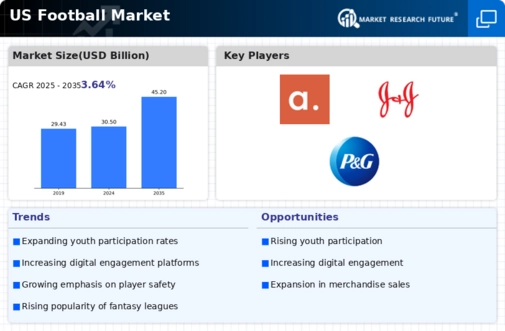Youth Development Programs
Investment in youth development programs is emerging as a critical driver in the football market. These initiatives aim to cultivate young talent and foster a love for the sport among children. Various organizations and clubs are establishing academies and training camps, which have seen participation rates increase by over 30% in recent years. This focus on youth development not only enhances the skill level of future players but also builds a strong community around the sport. By engaging families and local communities, these programs contribute to a sustainable growth model for the football market. Furthermore, as young players progress through these systems, they may eventually contribute to professional teams, creating a pipeline of talent that supports the long-term viability of the industry.
Rising Popularity of Major Leagues
The increasing viewership and attendance at major football leagues, such as Major League Soccer (MLS), is a key driver in the football market. In recent years, MLS has experienced a surge in popularity, with average attendance figures reaching approximately 20,000 fans per game. This growth in fan engagement is indicative of a broader trend within the football market, where the demand for live sports experiences continues to rise. The expansion of franchises and the introduction of new teams have also contributed to this trend, as cities across the US embrace football culture. Furthermore, the league's strategic partnerships with international clubs and brands enhance its visibility, potentially attracting a younger demographic. This evolving landscape suggests that the football market is poised for continued growth as it captures the interest of diverse audiences.
Sponsorship and Advertising Growth
The football market is witnessing a notable increase in sponsorship and advertising revenues, driven by the sport's rising popularity. Major brands are increasingly investing in football sponsorships, with expenditures reaching approximately $1 billion annually in the US. This influx of capital is not only beneficial for teams and leagues but also enhances the overall visibility of the sport. Sponsorship deals often include extensive marketing campaigns that leverage social media and digital platforms, further amplifying brand reach. The collaboration between football clubs and corporate sponsors is indicative of a mutually beneficial relationship that fuels growth in the football market. As brands seek to connect with passionate fan bases, the potential for increased investment in football-related initiatives appears promising, suggesting a robust future for the industry.
Technological Advancements in Broadcasting
Technological innovations in broadcasting are transforming the way fans engage with the football market. The advent of high-definition streaming services and mobile applications has made it easier for fans to access live matches and highlights. According to recent data, over 50% of football fans in the US now prefer to watch games via digital platforms rather than traditional cable television. This shift indicates a significant change in consumer behavior, as younger audiences gravitate towards on-demand content. Additionally, the integration of augmented reality (AR) and virtual reality (VR) experiences into match viewing is enhancing fan engagement, providing immersive experiences that were previously unavailable. As these technologies continue to evolve, they are likely to play a crucial role in shaping the future of the football market, potentially increasing viewership and fan loyalty.
Increased Accessibility of Football Facilities
The expansion and improvement of football facilities across the US are playing a pivotal role in the growth of the football market. Local governments and private investors are increasingly funding the construction of new stadiums and training facilities, which are designed to accommodate larger crowds and provide better amenities. Recent reports indicate that investment in sports infrastructure has surged, with over $2 billion allocated to football-related projects in the past year alone. This increased accessibility not only enhances the matchday experience for fans but also encourages participation at the grassroots level. As more communities gain access to quality facilities, the potential for talent development and fan engagement appears to grow, suggesting a positive trajectory for the football market.














Leave a Comment